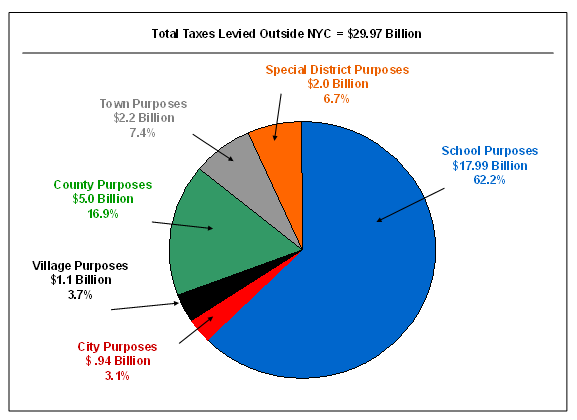Property taxes
In New York State, the property tax is a local tax, raised and spent locally to finance local governments and public schools. While the State itself does not collect or receive any direct benefit from the property tax, this tax is still of major importance as the largest single revenue source for the support of municipal and school district services.
Counties, cities, towns, villages, school districts, and special districts use property taxes to fund:
- schools
- police and fire protection
- road maintenance
- many other municipal services
Property taxes are based on the value of real property
The property tax is an ad valorem tax, meaning that it is based on the value of real property. Real property (commonly known as "real estate") is land and any permanent structures on it.
Without accounting for exemptions, properties of equal value in the same community should pay the same amount in property taxes. The owners of more valuable properties should pay more in taxes than the owner of less valuable properties.
Unlike many states, there is no personal property tax in New York. Rather than taxing items such as jewelry and vehicles, only real property is taxed.
Where the property tax goes
School districts are the largest users of the property tax. In fiscal years ending in 2009, local governments and school districts outside of New York City levied $28.87 billion in property taxes. Of that, 62 percent was levied by schools and 17 percent by counties. The remaining 21 percent was divided among towns, special districts, cities and villages.

Total Taxes Levied outside New York City equals $29.97 Billion. Breakdown is:
- City purposes accounts for $0.94 Billion or 3.1%;
- village purposes $1.1 billion or 3.7%;
- county purposes $5.0 billion or 16.9%;
- town purposes $2.2 billion or 7.4%;
- special district purposes $2.0 billion or 6.7%;
- school purposes $17.99 billion or 62.2%
Determine if your local taxes are increasing
To determine if your local taxes are increasing, you should examine tax levies not tax rates. Tax rates are not accurate indicators of how much more a school district or local government is collecting in taxes this year. This is because tax rates are based on the total taxable assessments in school district or municipality. If the value of property in the jurisdiction changes, that will skew the tax rate. For example:
- a town increases its assessments but keeps the tax rate the same. As a result of the increased assessments, the town collects more in taxes. To collect the same amount in taxes, the tax rate should drop proportionally.
If you want to know if the school district, city, town, or county is spending more, look at the budget. If you want to know if it's collecting more in taxes, look at the levy and the total amount to be collected in taxes.